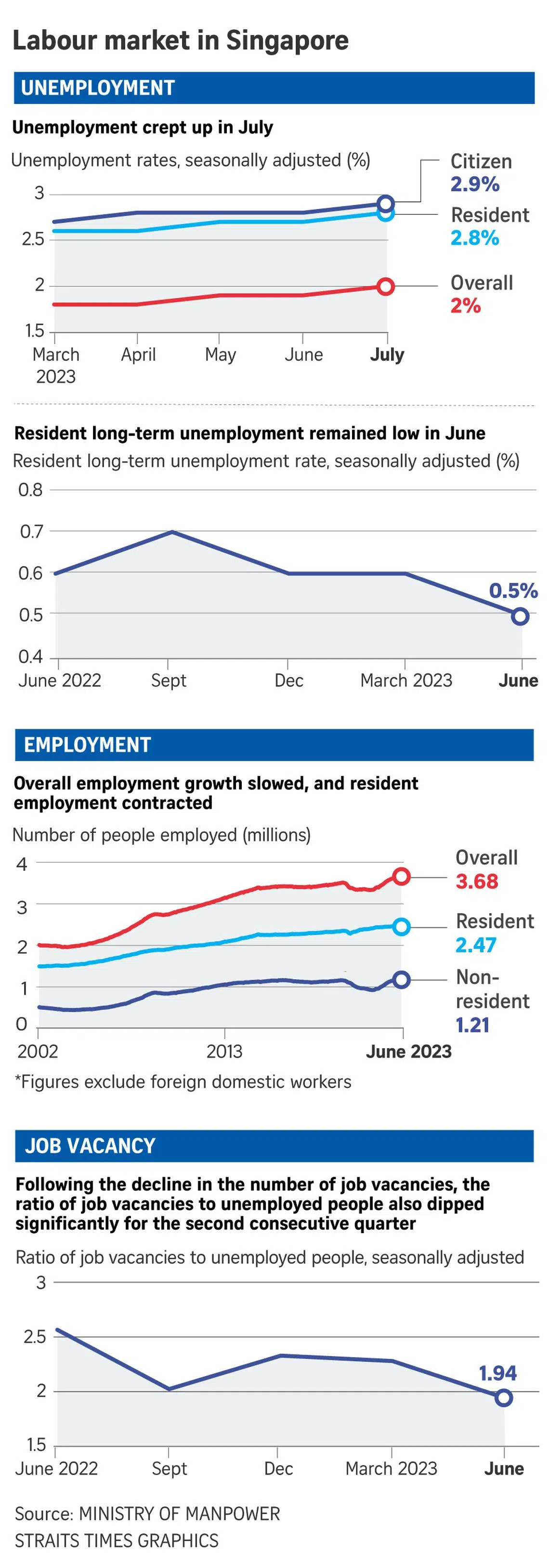S’pore job vacancies fall in Q2, unemployment ticks up in July as labour market continues to cool
Sign up now: Get ST's newsletters delivered to your inbox

Overall unemployment was 2 per cent in July on a seasonally-adjusted basis, up from 1.9 per cent in June.
ST PHOTO: KUA CHEE SIONG
Follow topic:
SINGAPORE – In the latest signs that Singapore’s labour market is cooling, unemployment crept up in July, and the demand for workers dropped again in the second quarter of 2023.
Overall unemployment was 2 per cent in July on a seasonally adjusted basis, up from 1.9 per cent in June.
The rate for Singaporeans was 2.9 per cent in July, from 2.8 per cent in June, according to Ministry of Manpower (MOM) data.
For residents – citizens and permanent residents – the rate rose to 2.8 per cent in July, from 2.7 per cent in June.
However, data for the April to June quarter released by MOM on Thursday showed the resident long-term unemployment rate came down slightly to 0.5 per cent in June, from 0.6 per cent in March.
The rate measures the proportion of unemployed residents who are out of work for at least 25 weeks.
Meanwhile, the number of job vacancies declined for the fifth consecutive quarter to 87,900 in June, down 12 per cent from 99,600 in March.
The figure has been descending from the peak of 126,000 in March 2022 right after the Covid-19 pandemic.
About one in five vacancies in June 2023 was in the professional services, information and communications, and financial services sectors.
Manpower Minister Tan See Leng said on Thursday that unemployment rates may inch up, albeit modestly, in the coming months.
“Our businesses and workers have to be prepared for the downside risks in the global economy going forward,” he said, speaking to reporters about the labour market statistics on a visit to marine and offshore engineering firm Dyna-Mac Engineering Services.
But he added: “The labour market has remained stable in the first half of this year, in spite of a weaker economic outlook.
“I am encouraged by the resilience of our businesses as well as our workers, and our labour market’s steady recovery since the pandemic.”
While there were fewer vacancies in June, there remain almost two job openings for each unemployed worker.
The ratio of job vacancies to unemployed workers was 1.94 in June, down from 2.28 in March.
Singapore’s overall employment expanded in the second quarter of the year for the seventh consecutive quarter, but at a slower pace.
The number of workers in jobs grew by 24,300 in the second quarter, down from 33,000 in the previous quarter.
The number of foreigners in jobs grew by 25,500 in the second quarter, while the number of employed residents shrank by 1,200.
This took total employment to 3.68 million in June, excluding foreign domestic workers.
On the higher number of foreigners in jobs, MOM said the majority of them were from work permit holders in the construction industry.
Mr Ang Boon Heng, director of manpower research and statistics at MOM, said resident employment numbers tend to change seasonally, and the current shrinkage is unlikely to persist.
He said: “Usually in the second half of the year, close to September until December, sometimes stretching a little bit into Chinese New Year, we have all these festivities – such as Formula One coming up this weekend – and hiring will go up for temporary positions.”
Resident employment growth in the third and fourth quarters is expected to be boosted by the recovery in tourism, said Mr Ang.
“However, increases will likely be lower than in the same period in the previous year, in line with the cooling labour demand, as well as lower resident labour force growth,” he said.
Economists said that although the weakening demand for labour is likely to persist, the outlook is uneven across different sectors.
Associate Professor in Practice Terence Ho, from the Lee Kuan Yew School of Public Policy at the National University of Singapore, said that outward-oriented sectors will be more affected by slowing external demand.
“Labour demand will likely remain strong in healthcare and other community, social and personal services, as well as tourism-related sectors, given the growth in domestic needs as well as the recovery in tourism,” he said.
DBS Bank economist Chua Han Teng noted that labour demand remains higher than the pre-pandemic quarterly average in the years 2017 to 2019.
“The second quarter’s resident employment contraction is not concerning to us, given that the decline was due to seasonal factors, and the resident unemployment rate remained low.
“Moreover, resident employment is expected to rebound in the second half of 2023, helped by the recovery in tourism-linked sectors such as accommodation and food and beverage services,” said Mr Chua.
Thursday’s data showed that retrenchments declined in the second quarter of the year, after rising for three consecutive quarters.

About 3,200 workers were let go between April and June, down from 3,820 in the preceding quarter.
MOM said many of the layoffs in the second quarter were in the information and communications sector, where business reorganisation or restructuring was a concern.
But it stressed that firms in the industry are still looking to hire, with 6,700 openings in June.
About seven in 10 workers retrenched from the sector were able to find jobs within six months, the ministry added.
However, in the overall economy, there was a steep drop in the proportion of retrenched residents who were back in a job within six months.
This re-entry into employment rate was 59.4 per cent in the second quarter, down from 71.7 per cent in the first quarter of 2023.
Among professionals, managers, executives and technicians, only 57.7 per cent were in employment in the second quarter after being retrenched six months earlier, down from the rate of 71.5 per cent for the previous quarter.
MOM said in its report on the data that the decline in the overall re-entry rate was led by younger workers aged below 30, who could be taking breaks from searching for a job as the long-term unemployment rate for this age group stayed low.
The re-entry rate for men and degree-holders also dropped from the first quarter of the year.
Mr Lim Ah Cheng, executive chairman and chief executive at Dyna-Mac, told The Straits Times that while the labour market shows signs of cooling, the company is still actively looking for talent.
“If you look at our hardware, we are nothing compared to the big yards in China,” he said.
“What differentiates us is the people and the system that we have set up. (We have to) retain and strengthen our employees, must motivate them. And we have to grab talent.”
Mr Lim added that in order to stay ahead, the company has to move with the times, and work with the various educational institutions as well as the authorities to train and up-skill workers, as well as move towards growth areas such as sustainability.


